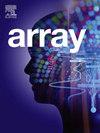MobDenseNet: A hybrid deep learning model for brain tumor classification using MRI
IF 2.3
Q2 COMPUTER SCIENCE, THEORY & METHODS
引用次数: 0
Abstract
This paper presents MobDenseNet, an improved deep learning model that assists medical practitioners in diagnosing brain tumors accurately. The proposed MobDenseNet is developed using the concepts of existing deep learning models: MobileNetV1 and DenseNet; the model incorporates hyperparameter fine-tuning and feature fusion ensemble during the feature extraction phase, consolidating layers like batch normalization, dense layers in the classification step to classify brain tumors. The classification is done into multiple classes, including, gliomas, meningiomas, pituitary, and healthy brain. The performance of the proposed model is assessed on two benchmark datasets. The experiments consider 2757 training and 307 testing images for the first dataset of 3064 MRI images, available on Figshare, having classes of glioma, meningioma, and pituitary. The experiment for the second dataset, has 2937 training and 327 testing images with glioma, meningioma, pituitary, and no tumor classes. The model achieves 98.4 % accuracy, 99.9 % AUC, 98.6 % precision, 98.40 % recall, 98.5 % F1-score for the Figshare dataset, and 96.02 % accuracy, 99.4 % AUC, 96.3 % precision, 95.7 % recall and 95.9 % F1-score for the Sartaj Bhuvaji dataset, respectively. The proposed MobDenseNet shows better accuracy than the existing models considered in the research. To demonstrate the effectiveness of the proposed model on diverse and unseen data, cross-dataset evaluations are conducted, where the model is trained using the Figshare dataset and tested using the Sartaj Bhuvaji and two additional datasets. Results indicate that even for the cross-dataset scenario, the proposed model achieves acceptable classification accuracy and outperforms existing models of MobileNetV1 and DenseNet.
MobDenseNet:一种用于MRI脑肿瘤分类的混合深度学习模型
本文介绍了MobDenseNet,这是一种改进的深度学习模型,可以帮助医生准确诊断脑肿瘤。提出的MobDenseNet是使用现有深度学习模型的概念开发的:MobileNetV1和DenseNet;该模型在特征提取阶段结合超参数微调和特征融合集成,在分类阶段整合批归一化、密集层等层对脑肿瘤进行分类。分类分为多种类型,包括胶质瘤、脑膜瘤、垂体瘤和健康脑。在两个基准数据集上对该模型的性能进行了评估。实验考虑了2757张训练图像和307张测试图像,第一个数据集有3064张MRI图像,可在Figshare上获得,分为胶质瘤、脑膜瘤和垂体。第二个数据集的实验,有2937个训练图像和327个测试图像,包括胶质瘤、脑膜瘤、垂体和无肿瘤类别。该模型对Figshare数据集的准确率为98.4%,AUC为99.9%,精密度为98.6%,召回率为98.40%,F1-score为98.5%;对Sartaj Bhuvaji数据集的准确率为96.02%,AUC为99.4%,精密度为96.3%,召回率为95.7%,F1-score为95.9%。所提出的MobDenseNet比研究中考虑的现有模型具有更好的准确性。为了证明所提出的模型在各种未知数据上的有效性,进行了跨数据集评估,其中使用Figshare数据集对模型进行了训练,并使用Sartaj Bhuvaji和另外两个数据集进行了测试。结果表明,即使在跨数据集场景下,所提出的模型也达到了可接受的分类精度,并且优于现有的MobileNetV1和DenseNet模型。
本文章由计算机程序翻译,如有差异,请以英文原文为准。
求助全文
约1分钟内获得全文
求助全文

 求助内容:
求助内容: 应助结果提醒方式:
应助结果提醒方式:


